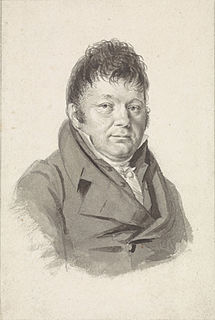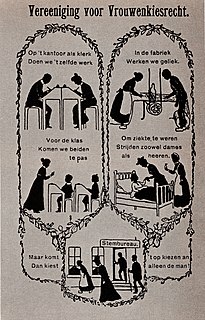
The Kunstmuseum Den Haag is an art museum in The Hague in the Netherlands, founded in 1866 as the 'Museum voor Moderne Kunst'. Later, until 1998, it was known as 'Haags Gemeentemuseum', and until the end of September 2019 as 'Gemeentemuseum Den Haag'. It is renowned for its large Mondrian collection, the largest in the world. His last work, Victory Boogie-Woogie, is on display here.
Ghiselin Danckerts was a Dutch composer, singer, and music theorist of the Renaissance. He was principally active in Rome, in the service of the Papal Chapel, and was one of the judges at the famous debate between Nicola Vicentino and Vicente Lusitano in 1551.
Benedictus Appenzeller was a Franco-Flemish singer and composer of the Renaissance, active in Bruges and Brussels. He served Dowager Queen Mary of Hungary for much of his career, and was a prolific composer of vocal music, both sacred and secular, throughout his long career.
The Royal Netherlands Chemical Society is a learned society and professional association founded in 1903 to represent the interests of chemists and chemical engineers in the Netherlands. Currently the organisation has approximately 7,400 members.

Carel Anton Fodor or Carolus Antonius Fodor was a Dutch pianist, conductor, and the most prominent composer of his generation in the Netherlands, writing in the manner of Joseph Haydn.
Vasilissa ergo gaude is an isorhythmic motet by the Renaissance composer Guillaume Dufay. In terms of its subject matter, it is sometimes grouped together with Lamentatio sanctae matris ecclesiae Constantinopolitanae, Apostolus gloriosus and Balsamus et munda cera which are generically called Dufay's Byzantine motets. Its composition was occasioned by the marriage on 21 January 1421 of Cleofa Malatesta, daughter of Malatesta di Pandolfo, to Theodore II Palaiologos, son of the Byzantine emperor Manuel II and Despot of the Morea. It has been surmised that the actual motet was composed in 1420 and is perhaps the earliest example of this choral form if not the earliest work attributed to Dufay. In earlier scholarship it was assumed that the motet's first performance had taken place on May 19, 1419, during the festivities prior to the marriage
Servaes de Koninck, or Servaes de Konink, Servaas de Koninck or Servaas de Konink, or Servaes de Coninck was a Flemish baroque composer of motets, Dutch songs, chamber and incidental music, French airs and Italian cantatas. After training and starting his career in Flanders he moved to Amsterdam in the Dutch Republic, where he was active in circles connected to the Amsterdam Theatre.

Josina Anna Petronella van Aerssen, married name Baroness Giustina Boetzelaer was a Dutch composer, painter, lady in waiting and noble.

The Nederlands Tijdschrift voor Geneeskunde is the main medical journal in the Netherlands, appearing weekly. Established in 1857, it is one of the world's oldest journals. Its publication language is exclusively Dutch. The journal is published and supported by the Vereniging NTvG, which is currently composed of 209 medical scientists. The current editor-in-chief is Yolanda van der Graaf. The Journal's headquarter is situated in Amsterdam, the Netherlands. From early on, the objective was to create an overarching and all-encompassing journal for medical professionals to exchange insights, knowledge and opinion, and to guarantee consistent progress throughout the country. At present, the main sections include: News, Opinion, Research, Clinical Practice, Perspective. Nowadays, the NTvG focuses on reviews and commentaries of research articles which are often published in English. Further, it continues to produce research of medical practice mainly in the Netherlands.

Johan van der Meer was a Dutch choral conductor and pioneer in the field of historically informed performance. He founded the Groningse Bachvereniging.
A royal chapel is a chapel associated with a monarch, a royal court, or in a royal palace.
BMGN: Low Countries Historical Review is a peer-reviewed open-access academic journal covering the history of the Low Countries, which is taken to include the Netherlands and Belgium and their colonial and international involvements. It is published by the Royal Netherlands Historical Society, with articles appearing either in Dutch or in English. In June 2018 it was announced that Dirk Jan Wolffram would be taking over as chair of the editorial board.

The Vereeniging voor Vrouwenkiesrecht was a women's rights organization active in the Netherlands from 1894 to 1919. It was devoted to women's suffrage. It was the main women's suffrage movement in the Netherlands. The Vereeniging changed its name in 1919 and would fuse with another association in 1930 and again in 1949 and still exists today.
Johannes Sticheler or Johannes Stickels is a 15th-century composer known primarily from his Missa se j'avoye porpoin de valeur in Vienna, Nationalbibliothek, MS 1 1883. He is possibly the same composer as Jonnes Estiche, known for an Ave Maris Stella and a motet or mass section Et incarnatus est.

Rijnsburg Abbey was a Benedictine nunnery in Rijnsburg, Netherlands, active between 1133 until 1574.

As of 2018, Wolters Kluwer ranks as the Dutch biggest publisher of books in terms of revenue. Other notable Dutch houses include Brill and Elsevier.
Hendrika Henriëtte Cornelia Stants, known as Iet Stants, was a Dutch composer.
Emile [Emmanuel Gerhardus Johannes] Wennekes born July 19, 1963, Doetinchem, is a Dutch musicologist, Full Professor at Utrecht University for the Chair: Music and Media.
The Missa Mi-mi is a musical setting of the Ordinary of the Mass by Johannes Ockeghem. It is a motto mass based on one of Ockeghem's own chansons, "Presque transi." The mass contains several motives and ideas from this chanson beyond just the head-motive.

Albertus Antonius Smijers, was a Dutch musicologist who served as Professor of Musicology at the University of Utrecht. He was a noted authority on Josquin des Prez—44 volumes of Werken van Josquin des Prez were published in his lifetime, and another 11 after his death.









